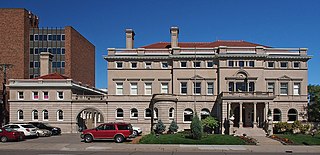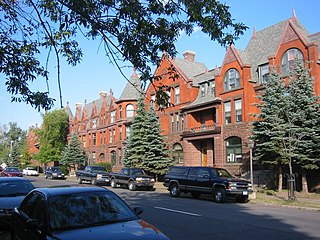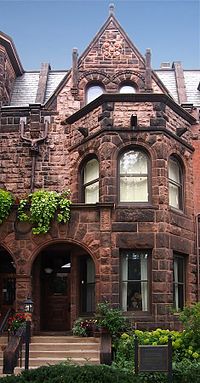
In architecture and city planning, a terrace or terraced house (UK) or townhouse (US) is a form of medium-density housing that originated in Europe in the 16th century, whereby a row of attached dwellings share side walls. In the United States and Canada they are also known as row houses or row homes, found in older cities such as Philadelphia, Baltimore, and Toronto.
Purcell & Elmslie (P&E) was the most widely know iteration of a progressive American architectural practice. P&E was the second most commissioned firm of the Prairie School, after Frank Lloyd Wright. The firm in all iterations was active from 1907 to 1921, with their most famous work being done between 1913 and 1921.

The Chicago, Milwaukee, St. Paul and Pacific Depot Freight House and Train Shed, now officially named The Depot, is a historic railroad depot in downtown Minneapolis, Minnesota, United States. At its peak, the station served 29 trains per day. Following decline, the station was closed and eventually adapted into various other uses.

The Frank B. Kellogg House is a historic house at 633 Fairmount Avenue in Saint Paul, Minnesota, United States. It is listed as a National Historic Landmark for its association with Nobel Peace Prize-winner Frank B. Kellogg, co-author of the Kellogg–Briand Pact. Kellogg Boulevard in downtown Saint Paul is also named for him. The house was designated a National Historic Landmark in 1976. It is also a contributing property to the Historic Hill District.

Clarence Wesley "Cap" Wigington (1883-1967) was an American architect who grew up in Omaha, Nebraska. After winning three first prizes in charcoal, pencil, and pen and ink at an art competition during the Trans-Mississippi Exposition in 1899, Wigington went on to become a renowned architect across the Midwestern United States, at a time when African-American architects were few. Wigington was the nation's first black municipal architect, serving 34 years as senior designer for the City of Saint Paul, Minnesota's architectural office when the city had an ambitious building program. Sixty of his buildings still stand in St. Paul, with several recognized on the National Register of Historic Places. Wigington's architectural legacy is one of the most significant bodies of work by an African-American architect.

Summit Avenue is a street in St. Paul, Minnesota, United States, known for being the longest avenue of Victorian homes in the country, having a number of historic houses, churches, synagogues, and schools. The street starts just west of downtown St. Paul and continues four and a half miles west to the Mississippi River where Saint Paul meets Minneapolis. Other cities have similar streets, such as Prairie Avenue in Chicago, Euclid Avenue in Cleveland, and Fifth Avenue in New York City. Summit Avenue is notable for having preserved its historic character and mix of buildings, as compared to these other examples. Historian Ernest R. Sandeen described Summit Avenue as "the best preserved example of the Victorian monumental residential boulevard."

Saint Paul, Minnesota is noted for its neighborhoods. The city has been called "fifteen small towns with one mayor", owing to the neighborhood-based life of much of the city. Saint Paul is partially governed by not 15 but 17 City Districts.

The George R. Newell House, also known as Chateau LaSalle, is a historic house in the Stevens Square-Loring Heights neighborhood of Minneapolis. It was originally built for Sumner T. McKnight, a businessman who had interests in lumber and real estate. McKnight sold it almost immediately to George R. Newell, one of the founders in 1870 of the grocery firm Stevens, Morse and Newell. When Newell died in 1921, his son L.B. Newell inherited the company and changed its name to SuperValu. In later years the Chateau was owned by the Freerks family and run as an apartment complex.

The Church of Saint Agnes is a Catholic church of the Archdiocese of Saint Paul and Minneapolis. The parish was founded in 1887 and the current church building was completed in 1912 and listed on the National Register of Historic Places in 1980.

The Dr. Ward Beebe House, also known as the John Leuthold Residence, is a three-story stucco prairie house built by Dr. Ward and Bess Beebe and designed by Purcell and Elmslie in 1912. Purcell and Elmslie were prolific designers of prairie style homes. It is located in the West Summit Avenue Historic District, in Saint Paul, Minnesota, United States.

The Anne C. and Frank B. Semple House is a historic house in the Stevens Square/Loring Heights neighborhood of Minneapolis, Minnesota, United States. It is located on the same block as the George R. Newell House and the George W. and Nancy B. Van Dusen House. The house was listed on the National Register of Historic Places in 1998.

Chester Terrace is a historic rowhouse in Duluth, Minnesota, United States. Built in 1890, it was designed in Romanesque Revival style by Oliver G. Traphagen and Francis W. Fitzpatrick. It was listed on the National Register of Historic Places in 1980 for its local significance in the theme of architecture. It was nominated as one of Duluth's outstanding examples of a Romanesque Revival rowhouse.

Munger Terrace is an architecturally significant rowhouse in the Central Hillside neighborhood of Duluth, Minnesota, United States. It was designed by Oliver G. Traphagen and Francis W. Fitzpatrick and built from 1891 to 1892, originally containing eight luxury townhomes. Munger Terrace was listed on the National Register of Historic Places in 1976 for its local significance in the theme of architecture. It was nominated for being Duluth's finest example of Châteauesque architecture applied to an apartment building.

Edward Payson Bassford (1837–1912) was an architect who practiced in St. Paul, Minnesota, in the late 19th century. Born in Calais, Maine, on June 7, 1837, he moved to St. Paul in 1866. He worked in the office of Abraham Radcliffe for a time, then founded his own architectural firm. By the 1870s, Bassford was the busiest architect in St. Paul, working on designs for houses, schools, and many commercial buildings. His firm also employed architects who later were famous in their own right, such as Cass Gilbert, Augustus Gauger, Edward J. Donohue, Silas Jacobson, and Charles Bassford. He died in Osakis, Minnesota, on July 20, 1912.

The Hollywood Theater is a historic theater building in Minneapolis, Minnesota, United States, which is listed on the U.S. National Register of Historic Places. The Art Deco theater building opened on October 26, 1935, and the marquee proclaimed it the "Incomparable Showcase of the Northwest". The theater, designed by architects Jack Liebenberg and Seeman Kaplan, had a generous budget that allowed for elaborate decoration in the Streamline Deco style of design; its facade and structure made a "powerful statement of geometric mass punctuated by the entrance, exits, and three small windows that served the projection booth." Liebenberg and Kaplan went on to design the Riverview Theatre in Minneapolis and the Terrace Theatre in Robbinsdale. The building featured a tall vertical sign, a patterned terrazzo floor, gilded pillars, and acoustical tiles in geometric patterns. It had a seating capacity of just under 1000. Much of the interior features are influenced by the Zig-Zag Moderne and Streamline Moderne styles. The exterior is built of smooth Kasota limestone with vertical lines that transition to horizontal.

Carl F. Struck was a Norwegian American architect, who designed private residences, civic buildings and commercial structures throughout the Midwest in the latter part of the 19th century.
Liebenberg and Kaplan (L&K) was a Minneapolis architectural firm founded in 1923 by Jacob J. Liebenberg and Seeman I. Kaplan. Over a fifty-year period, L&K became one of the Twin Cities' most successful architectural firms, best known for designing/redesigning movie theaters. The firm also designed hospitals, places of worship, commercial and institutional buildings, country clubs, prestigious homes, radio and television stations, hotels, and apartment buildings. After designing Temple Israel and the Granada Theater in Minneapolis, the firm began specializing in acoustics and theater design and went on to plan the construction and/or renovation of more than 200 movie houses throughout Minnesota, North and South Dakota, Iowa, and Wisconsin. Architectural records, original drawings, and plans for some 2,500 Liebenberg and Kaplan projects are available for public use at the Northwest Architectural Archives.

Charles Sumner Sedgwick was an American architect based in Minneapolis, Minnesota.

The Turtle Bay Gardens Historic District is a collection of twenty rowhouses in the Turtle Bay neighborhood of Manhattan in New York City. They consist of eleven houses on the south side of 49th Street and nine on the north side of 48th Street, between Second and Third Avenues. The rowhouses, dating from the 1860s, were renovated between 1918 and 1920 by Charlotte Hunnewell Sorchan to plans by Clarence Dean.




















